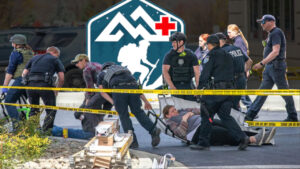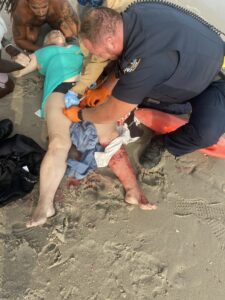5 Reasons Why Cops NEED Active Shooter Trauma Kits

The constant threat of an Active Shooter Incidents means Law Enforcement and EMS agencies need to continually develop new strategies to fight this danger. The general accepted philosophy around active shooter response is: The 1st officer(s) on scene does not wait for back up like they might for other types of dangerous calls.
In this new strategy, the first responding officer immediately rushes onto the scene as quickly as possible, the officer advances toward the sound of gunfire until encountering the threat. If no active gunfire is present at the time of the officer’s arrival, a slow and painstaking search of every single room and hiding place begins. But, at the sound of gunfire, methodical room clearing is abandoned to rush the threat and stop the killing.
Teaching officers’ solo and 2-man CQB is an essential part of modern policing to prevent the unnecessary loss of life, but the work isn’t over after the threat’s been “Neutralized.”
The 2 Phases of Active Shooter Response
The unfortunate part of active shooter strategies means prioritizing the neutralization of the threat before seeing to the medical care of the injured victims, which are likely to be littering the hallways. Officers must step over these severely wounded to accomplish the 1st phase of the mission. But after that’s been done, next comes the 2nd phase of the strategy, saving lives.
An active shooter’s primary goal is to indiscriminately kill as many people as possible and create the greatest possible chaos, destruction, and pain. Our goal as first responders is to reduce that body count as far as possible and limit the effect this disturbed person has on our communities. If cops need weapons to protect and serve the American citizens, they also need trauma kits.
If you are going to carry the tools to punch holes in people, you need to carry the tools to patch holes in people.
5 Reasons Cops NEED Active Shooter Trauma Kits
1. Rapid Response Saves Lives: Time is critical. The longer officers wait to enter the scene, the more people will die. This was hard lesson was punctuated during the 1999 Columbine school shooting where officers staged outside the school for 40 minutes while the armed gunmen calmly walked around finding new victims. Officers are being trained not to wait for back-up before aggressing on the threat and this proven strategy has already saved many lives, then comes bleeding control and wound management. Officers need the gear to immediately shift from their combat roles to their medic roles to limit the effect of the shooter. The sooner victims receive medical care, the more likely they will be to survive.
2. Empowering Officers As First Responders: Giving cops trauma kits not only enhances their ability to provide immediate assistance but also empowers them as first responders. In the chaotic aftermath of an active shooter incident, officers often find themselves on the front lines, confronting injuries that demand swift intervention. A trauma kit becomes an extension of an officer's duty to protect and serve, allowing them to address critical injuries and stabilize victims until the paramedics arrive.
3. Mitigating Blood Loss: Uncontrolled bleeding is a leading cause of preventable death in trauma situations, including those resulting from active shooter events. Trauma kits are specifically designed to address this issue by providing tools to control bleeding effectively. Teaching officers the difference between wound packing and tourniquets is easy and inexpensive if done right. Our Emergency Trauma Response Course is completely free and will teach your officers the basics of trauma management. By mitigating blood loss, officers equipped with trauma kits and the skills to use them contribute significantly to the survival of victims and the overall effectiveness of active shooter response.

Shark attack: Rockaway Beach at 59th St. Victim is treated by officers after being attacked by a shark.
Photos acquired by the NYPost
4. Adaptability: Active shooter situations are inherently dynamic, unpredictable, incredibly dangerous, and require law enforcement to navigate a complex and rapidly changing environment. Mountain Man Medical Trauma kits are designed with this in mind, featuring compact and easily transportable components that can be carried by officers without hindering mobility. The adaptability of the Mass Casualty Trauma Kit ensures that officers respond effectively to various scenarios, from large-scale incidents in public places to confined spaces with only one bleeding victim.
5. Enhancing Officer Preparedness: Beyond immediate response, trauma kits contribute to overall officer preparedness for a broad range of emergency situations. Training officers in the use of trauma kits not only ensures competence in their application but also fosters a mindset of readiness, service, and care. The psychological impact of knowing they possess the tools to make a difference in the face of tragedy can bolster officer morale and resilience, which are crucial aspects to compassionate policing and maintaining effective law enforcement in the aftermath of traumatic events.
Docs Wrap Up
Cops need trauma gear. And they need to know how to use it. Officers are almost always the first responders to any scene and are therefore in the best possible place to control bleeding until EMS can arrive on scene to take over and transport the victim(s) to the hospital.
The rapid deployment of quality medical gear designed for rapidly evolving situations empowers officers to fulfill their duty as first responders.
By enhancing officer preparedness, and providing a means to address injuries swiftly, trauma kits emerge as a vital component of modern law enforcement, and ensures officers are equipped to protect and serve their communities in the face of great bodily danger.
As we strive for safer societies, the integration of trauma kits into police response protocols is forward thinking and demonstrates commitment to preserving life and minimizing the impact of tragic events.
